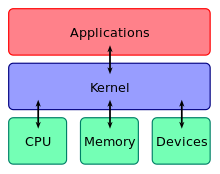The kernel is a computer program at the core of a computer's operating system with complete control over everything in the system.[1] It is the "portion of the operating system code that is always resident in memory".[2] It facilitates interactions between hardware and software components. On most systems, it is one of the first programs loaded on startup (after the bootloader). It handles the rest of startup as well as input/output requests from software, translating them into data-processing instructions for the central processing unit. It handles memory and peripherals like keyboards, monitors, printers, and speakers.
The critical code of the kernel is usually loaded into a separate area of memory, which is protected from access by application programs or other, less critical parts of the operating system. The kernel performs its tasks, such as running processes, managing hardware devices such as the hard disk, and handling interrupts, in this protected kernel space. In contrast, application programs like browsers, word processors, or audio or video players use a separate area of memory, user space. This separation prevents user data and kernel data from interfering with each other and causing instability and slowness,[1] as well as preventing malfunctioning application programs from crashing the entire operating system.
The kernel's interface is a low-level abstraction layer. When a process makes requests of the kernel, it is called a system call. Kernel designs differ in how they manage these system calls and resources. A monolithic kernel runs all the operating system instructions in the same address space for speed. A microkernel runs most processes in user space,[3] for modularity.[4]
This central component of a computer system is responsible for running or executing programs. The kernel takes responsibility for deciding at any time which of the many running programs should be allocated to the processor or processors.
|
- Home
- _Online Shop Low Price
- Software
- _Game.s
- _uptodown
- _filehippo
- _ninite
- _download.cnet
- _en.softonic
- _snapfiles
- _filehorse
- _filepuma
- Useful Site,s
- _Voice Changer Online
- _Youtube to FB
- _Remove Image
- _Free File Sharing Sites
- _Royalty Free Music
- _YouTube Banner Size
- _10MinuteMail
- _URL Shortener Money
- _Free Online Logo Maker
- All OS
- _Win-10 Download
- _Win OS Install
- _Win-8.1 Install
- _Win Product-Key
- _OS USB Bootable
- __Useful Videos
- __Free Software
- _Linux OS Download
- _Mac OS Download
- _All Win Product key
- _OLD-OS
- BTC App
- _PI Network Mining App
- _Eagle Crypto App
- File Shar
- _Upload Files
- _File Sharing-2
- _Dubbed Tamil Movie Down
- Movie
- _Hollywood Dub Movie Down
- __Dub tamil mov down
- __Tamil1DubMovie
- _Image Resizer
- _Linux OS
- EBook
- _Earn Money On Ebay
- Disclaimer
- Privacy Policy
- About Us



0 Comments